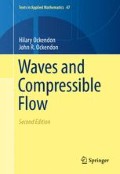Abstract
The time has come to face up to the task of making a mathematical model that can deal with flows containing shock waves or shocks, across which the various dependent physical variables themselves have discontinuities. Such discontinuities are often called jump discontinuities in contrast to situations in which only the derivatives of the physical variables have discontinuities.
Access this chapter
Tax calculation will be finalised at checkout
Purchases are for personal use only
Notes
- 1.
- 2.
- 3.
An alternative way of describing the flow through an oblique shock graphically is to use the shock polar as in Exercise 6.8.
- 4.
In view of the dimensionality arguments of Section 5.4.2 and Exercise 5.19, this phenomenon should not occur for a corner in an infinite wall. However, because the flow behind the shock at A is subsonic, the equations are locally elliptic, and the solution will depend on conditions downstream that will, in practice, involve a length scale which determines the stand-off distance and the shock curvature. We will see another example of such a configuration at the end of Section 6.2.2.
- 5.
Practical observations indicate that the transition from an undular bore to a turbulent bore occurs as the ratio of the increase in depth to the original depth increases through a value of around 0.3.
- 6.
Note that we have implicitly assumed that the flow is compressible. Clearly an incompressible flow can flow smoothly through any slowly varying nozzle.
- 7.
Depending on the aerofoil shape and angle of incidence, the leading edge could emit either two weak shock waves or a weak shock and a weak expansion wave.
- 8.
This Newtonian limit is not so unrealistic because molecular effects in hypersonic flows cause γ to decrease below 1.4 for air.
- 9.
References
Anderson, J. D. (1989). Hypersonic and high temperature gas dynamics. New York: McGraw-Hill.
Chapman, C. J. (2000). High speed flow. Cambridge: Cambridge University Press.
Courant, R., & Friedrichs, K. O. (1948). Supersonic flow and shock waves. New York: Interscience.
Davison, L. (2010). Fundamentals of shock wave propagation in solids. New York: Springer.
Edwards, C. M., Howison, S. D., Ockendon, H., & Ockendon, J. R. (2008). Non-classical shallow water flows. IMA Journal of Applied Mathematics, 73, 137–157.
Garabedian, P. R. (1964). Partial differential equations. New York: John Wiley and Sons.
Germain, P., & Lee, E. H. (1973). On shockwaves in elasto-plastic solids. Journal of the Mechanics and Physics of Solids, 21, 359–382.
Guderley, K. G. (1962). The theory of transonic flow. Elmsford, NY: Pergamon. Translated by J. R. Moszynski.
Hayes, W., & Probstein, R. (1959). Hypersonic flow. New York: Academic Press.
Howell, P. D., Ockendon, H., Ockendon, J. R. (2012). Mathematical modelling of elastoplasticity at high stress. Proceedings of the Royal Society A, 468, 3842–3863.
Keyfitz, B.-L. (1999). Conservation laws, delta shocks and singular shocks. In Nonlinear theory of generalised functions. Research notes in mathematics (pp. 99–111). Boca Raton: Chapman and Hall.
Lax, P. D. (1953). Nonlinear hyperbolic equations. Communications on Pure and Applied Mathematics, 6, 231–258.
Leveque, R. J. (2004). The dynamics of pressureless dust clouds and delta waves. Journal of Hyperbolic Differential Equations, 1, 315–327.
Liepmann, H. W., & Roshko, A. (1957). Elements of gas dynamics. New York: John Wiley and Sons.
Mora, P. (2003). Plasma expansion into a vacuum. Physical Review Letters, 90, 185002.
Newton, I. (1871). Principia. New York: Daniel Adee. Translated by A. Motte (1846).
Ockendon, J., Howison, S., Lacey, A., & Movchan, A. (1999). Applied partial differential equations. Oxford: Oxford University Press.
Perego, M., Howell, P. D., Gunzburger, M. D., Ockendon, J. R., & Allen, J. E. (2013). The expansion of a collisionless plasma into a plasma of lower density. Physics of Plasmas, 20, 052101.
Van Dyke, M. (1975). Perturbation methods in fluid dynamics. Stanford, CA: Parabolic.
Van Dyke, M. (1982). An album of fluid motion. Stanford, CA: Parabolic.
Whitham, G. B. (1974). Linear and nonlinear waves. New York: Wiley.
Author information
Authors and Affiliations
Rights and permissions
Copyright information
© 2015 Springer Science+Business Media New York
About this chapter
Cite this chapter
Ockendon, H., Ockendon, J.R. (2015). Shock Waves. In: Waves and Compressible Flow. Texts in Applied Mathematics, vol 47 . Springer, New York, NY. https://doi.org/10.1007/978-1-4939-3381-5_6
Download citation
DOI: https://doi.org/10.1007/978-1-4939-3381-5_6
Published:
Publisher Name: Springer, New York, NY
Print ISBN: 978-1-4939-3379-2
Online ISBN: 978-1-4939-3381-5
eBook Packages: Mathematics and StatisticsMathematics and Statistics (R0)




